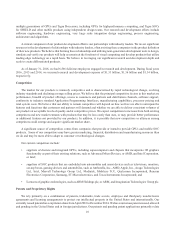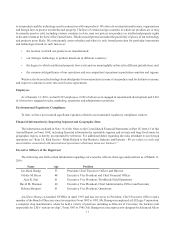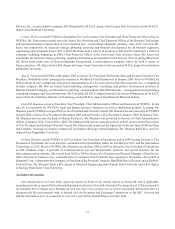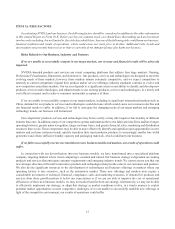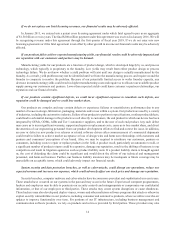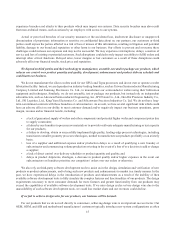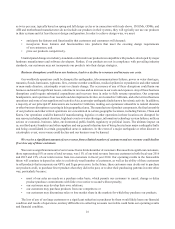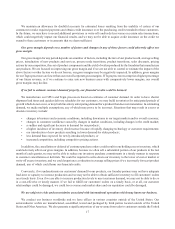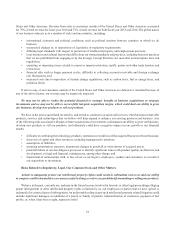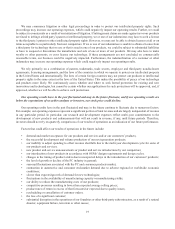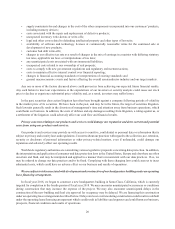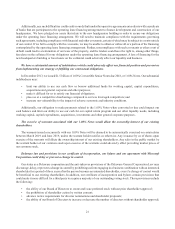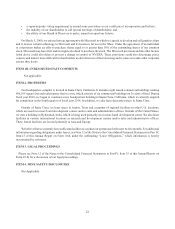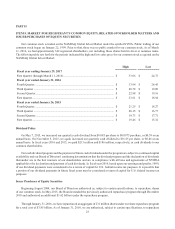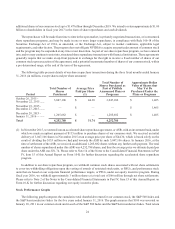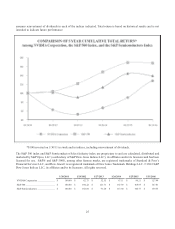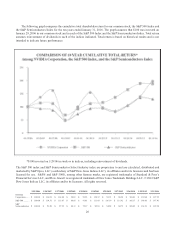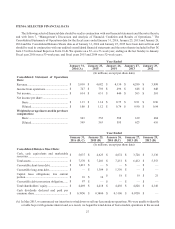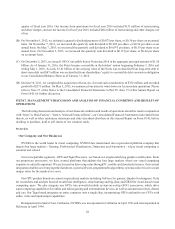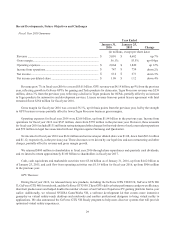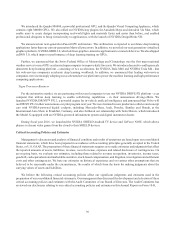NVIDIA 2016 Annual Report Download - page 166
Download and view the complete annual report
Please find page 166 of the 2016 NVIDIA annual report below. You can navigate through the pages in the report by either clicking on the pages listed below, or by using the keyword search tool below to find specific information within the annual report.20
• supply constraints for and changes in the cost of the other components incorporated into our customers’ products,
including memory devices;
• costs associated with the repair and replacement of defective products;
• unexpected inventory write-downs or write-offs;
• legal and other costs related to defending intellectual property and other types of lawsuits;
• availability of software and technology licenses at commercially reasonable terms for the continued sale or
development of new products;
• customer bad debt write-offs;
• changes in our effective tax rate as a result of changes in the mix of earnings in countries with differing statutory
tax rates, applicable tax laws or interpretations of tax laws;
• any unanticipated costs associated with environmental liabilities;
• unexpected costs related to our ownership of real property;
• costs to comply with new government regulations and regulatory enforcement actions;
• costs to maintain effective internal control over financial reporting;
• changes in financial accounting standards or interpretations of existing standards; and
• general macroeconomic events and factors affecting the overall semiconductor industry and our target markets.
Any one or more of the factors discussed above could prevent us from achieving our expected future financial results.
Any such failure to meet our expectations or the expectations of our investors or security analysts could cause our stock
price to decline or experience substantial price volatility and, as a result, investors may suffer losses.
In the past, securities class action litigation has often been brought against a company following periods of volatility
in the market price of its securities. We have been in the past, and may be in the future, the target of securities litigation.
Such lawsuits generally result in the diversion of management's time and attention away from business operations, which
could harm our business. In addition, the costs of defense and any damages resulting from litigation, a ruling against us, or
a settlement of the litigation could adversely affect our cash flow and financial results.
Privacy concerns relating to our products and services could damage our reputation and deter current and potential
users from using our products and services.
Our products and services may provide us with access to sensitive, confidential or personal data or information that is
subject to privacy and security laws and regulations. Concerns about our practices with regard to the collection, use, retention,
security or disclosure of personal information or other privacy-related matters, even if unfounded, could damage our
reputation and adversely affect our operating results.
Worldwide regulatory authorities are considering various legislative proposals concerning data protection. In addition,
the interpretation and application of consumer and data protection laws in the United States, Europe and elsewhere are often
uncertain and fluid, and may be interpreted and applied in a manner that is inconsistent with our data practices. If so, we
may be ordered to change our data practices and/or be fined. Complying with these changing laws could cause us to incur
substantial costs, which could have an adverse effect on our business and results of operations.
We are subject to risks associated with development and construction of our headquarters building under an operating
lease financing arrangement.
In fiscal year 2016, we began to construct a new headquarters building in Santa Clara, California, which is currently
targeted for completion in the fourth quarter of fiscal year 2018. We may encounter unanticipated occurrences or conditions
during construction that may increase the expense of the project. We may also encounter unanticipated delays in the
construction of the new building and final city approval for occupancy may be delayed. We are financing this construction
under an operating lease arrangement described below. Delays and cost overruns during construction could result in a default
under the operating lease financing arrangement which could result in liabilities and expenses and could harm our business,
prospects, financial condition and results of operations.


